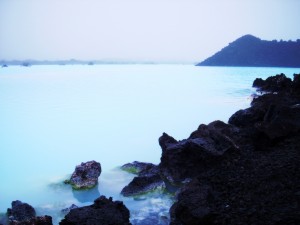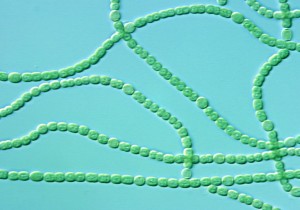by Kristen Minogue

The milky blue waters of this Iceland lagoon are teeming with cyanobacteria, also known as blue-green algae. (Marie-II)
Beneath the surface of the ocean, an invisible army of workers is fighting to keep climate change in check. Many have been silently absorbing or burying carbon for billions of years, and humanity has just begun to take notice of them. These unassuming laborers are bacteria.
Bacteria haven’t always enjoyed a favorable reputation even outside the world of germs – and with some reason. Just as there are disease-causing bacteria, there are plenty of planet-warming bacteria and archaea microbes. Methanogens (part of the Archaea domain) top the list as they spew out methane (CH4), a greenhouse gas almost 25 times more powerful that CO2. And of course the hundreds of thousands of bacterial species that decompose dead material can’t help returning CO2 to the atmosphere in the process.
But not all microbes are spurring on climate change. Some quietly counteract their more hotheaded cousins, and they’re starting to get the recognition they deserve.

Cyanobacteria chain. Cyanobacteria rank among the oldest organisms alive, quietly absorbing CO2 for 3.5 billion years. (James Golden/University of California, San Diego)
At the forefront are cyanobacteria, the ancient ancestors of plants. These “blue-green algae” invented photosynthesis, the process of absorbing carbon dioxide and releasing oxygen. They take what the decomposers do and turn it upside-down. Instead of breaking down organic matter and turning it into CO2, they turn CO2 into organic matter, locking it away until something else comes along to break it down.
Cyanobacteria have already revolutionized the planet once. They transformed the atmosphere two and a half billion years ago, when they infused the methane- and ammonia-dominated skies with oxygen. The result (largely a matter of perspective) was either a catastrophic mass extinction or the prelude to oxygen-breathing life as we know it. Over time some cyanobacteria evolved into the green chloroplasts that enable plants to photosynthesize. Without them, forests wouldn’t be able to store carbon anymore than humans can.
Methanotrophs, which can be bacteria or archaea, do something similar for methane. Unlike methanogens (the methane-emitting microbes), methanotrophs mix methane (CH4) with oxygen, turning it into the less harmful CO2. It’s not a perfect solution, so their role in the climate wars is a bit grayer. But without them, a much more potent greenhouse gas would flood the atmosphere unchecked.
See also Marshes, Microbes and the Other Blue Carbon >>
Then there are bacteria that bury carbon so well practically nothing else can break it down. These microbes take sugars and amino acids in the ocean—molecules animals would normally digest and turn back into CO2—and convert them into “refractory molecules” that are much tougher to unlock. Scientists still haven’t figured out exactly what triggers the process, but it’s possible viral infections have something to do with it. If that’s true, we can thank bacteria and viruses for helping the fight against climate change.
Even bacteria that don’t eat greenhouse gases can make the planet less friendly for them. Hydrocarbon-eating bacteria, the kind that cleaned up the disastrous oil spill in 2010, can stop another harmful substance from entering the atmosphere: isoprene. Under the right conditions, isoprene can prolong the life of methane in the atmosphere. But on the coasts, the biggest isoprene hot spots, swarms of bacteria are consuming isoprene before it has a chance to reach the atmosphere.
All the evidence points to microbes as a force to be reckoned with. The real question is which side climate change will favor, the eaters or the emitters of greenhouse gases. Warmer temperatures speed up decomposition, a boon for bacteria that break down dead matter and release CO2. But other changes, such as higher acidity in the ocean, could tip the scale in ways scientists can’t predict. Researchers are slowly discovering which camps the different microbes fall into, but at this point it’s anyone’s game.
This article has been corrected. A previous version listed all the microbes as bacteria, but some (the methanogens and some methanotrophs) belong to the domain Archaea.
Images licensed for share under the Creative Commons license


These are NO BACTERIA!!!! ARCHAEA!!! THEY ARE CALLED ARCHAEA!!! and no Archaea are no bacteria!